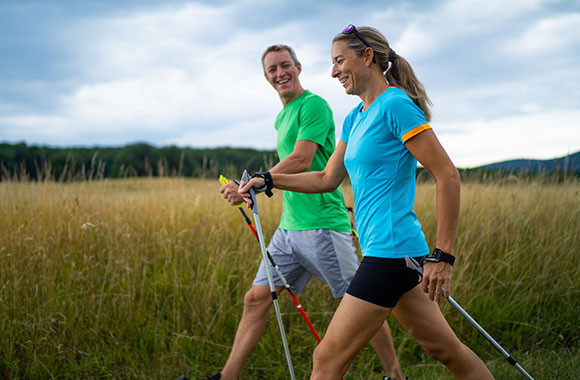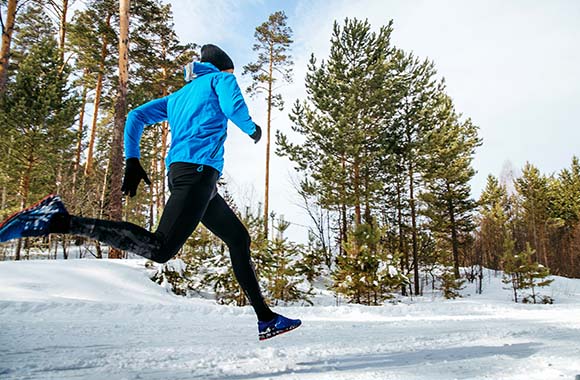Running training for beginners: Training, exercises & nutrition tips
Successful running training consists of stress phases, in which you train your performance, and rest phases, in which your body recovers and adapts. For beginners, it is not always easy to create a balanced running training programme or to choose the right type of training.
From the wide range of training options, we would like to introduce you to some of the most popular ones. We also introduce how a healthy diet can support your training and show you some tracking gadgets that can be useful for running training.
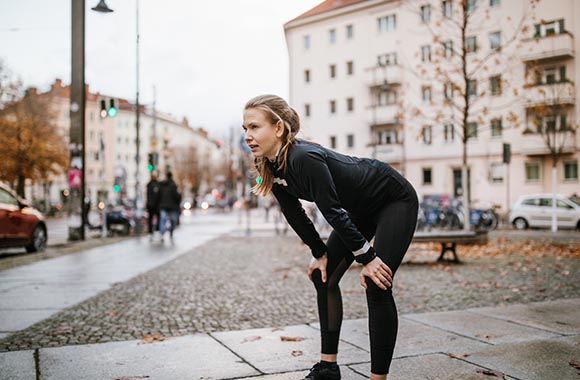
Table of contents
The 1x1 of running training: Basics of successful running training
The aim of running training is to increase endurance and speed and to improve technique through specific running exercises. This should ensure your training success overall: A healthy running style that prevents injuries and strains is also learned and practised.
The following building blocks are crucial for successful and sustainable running training:
- Intensity: Beginners should increase their running speed slowly and not start with too intensive training units.
- Training duration: Endurance training is considered effective from about 30 minutes onwards. This duration is considered ideal for long, but not too intensive training sessions. Beginners can also achieve improvements after 20 minutes. Advanced runners often train for up to two hours at a time.
- Training frequency: Three training sessions a week is considered optimal. This means that there can always be a rest day between training days. But even one or two days a week is a good start for beginners.
- Healthy running technique: While running, you should keep an upright posture with an extended upper body. The shoulders should be relaxed, the arms active but loose. The feet should roll off the ground dynamically.
When running, you can choose from a variety of different workouts. It is best to combine several types of running training to introduce your body to new challenges over time and to keep improving your running technique.
What is the running ABC?
As the name “running ABC” suggests, these running exercises teach important technical basics that every runner should know. These exercises include ankling, high knees, butt kicks, carioca, and bounding. If you practice them regularly and conscientiously, the running ABC exercises can help you develop a healthy running technique and improve a running style: The movements of the running stride are precisely reproduced and trained – from pushing off the foot and lifting the knee to the foot strike. In addition, hip mobility is improved. Running becomes more "economical" – you move faster and can also protect your joints by running in a clean style.
How to train the running ABC
Beginners should choose about three to five workouts and incorporate them into their run. Coordination training is demanding and requires concentration, so don’t take on too much at once and don’t follow an intensive training session with running ABC:
- 10 minutes easy running as a warm-up
- 10 minutes of running ABC exercises
- 10 minutes easy running as a cool-down
Popular running ABC exercises to improve running technique
Ankling
Ankling trains your hip extension. It also improves the flexibility of the ankle joints.
- Lift your knee slightly upwards (alternate sides)
- Tip of the lifted foot points towards the floor
- Touch down on the ground, starting with the ball of the foot
- Transfer your weight from the ball of your foot to the heel
- Hips move with the foot, arms are bent
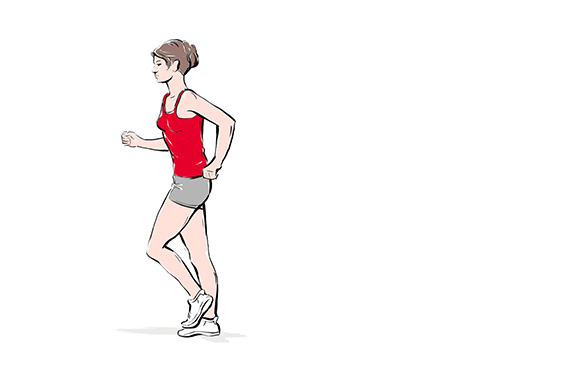
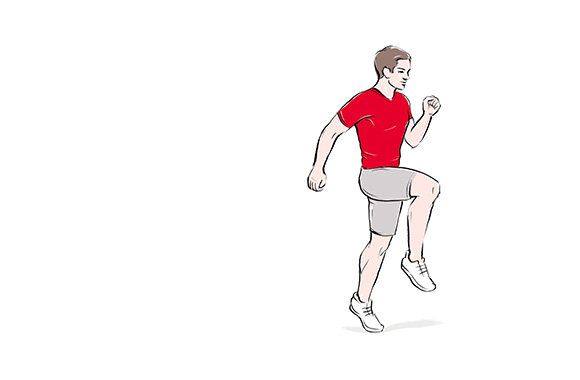
High knees
The high knee drill improves the hip flexors.
- Start with an active push-off (alternate sides)
- Raise one left to hip-height
- Hit the ground with the ball of your foot
- Upper body remains upright

Butt kicks:
The exercise strengthens the leg flexor muscles.
- Bring the lower legs up to the thighs.
- Heels touch the buttocks alternately
- Hips remain extended
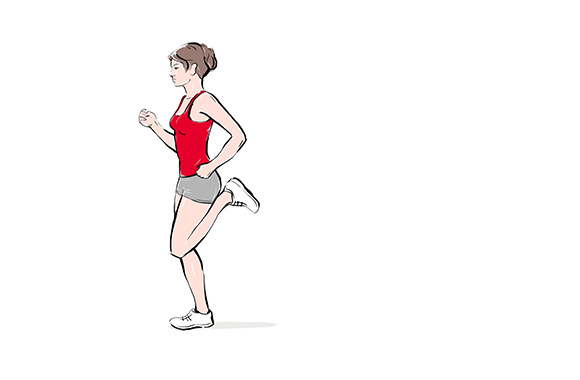
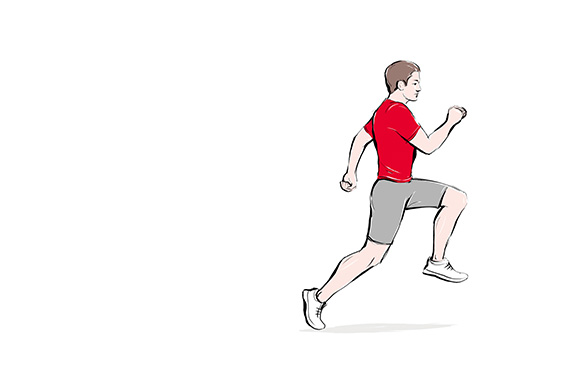
Bounding
Bounding strengthens leg and gluteal muscles.
- Powerful push-off from the ankle
- Leg is stretched to the maximum
- Other leg swung forward (not upwards)
- Thighs are horizontal in the flight phase.

Carioca
This exercise improves hip mobility.
- Cross your legs sideways
- Cross your right foot over your left foot, move hips to the left
- Bring your left foot over your right foot, move your right foot backwards
- Move your left foot to the side
- Arms are extended and parallel to the floor
- Upper body does not rotate
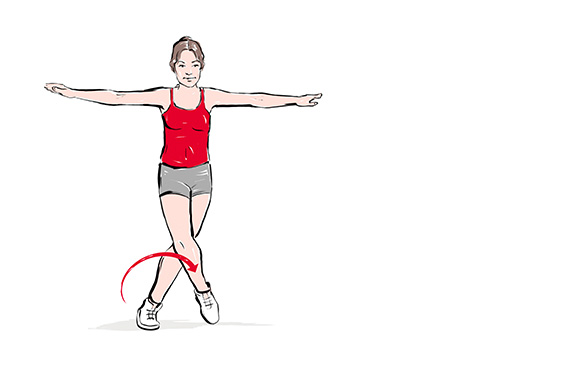
Skipping
The body extension is trained, and the footprint is strengthened.
- Powerful push-off from the ankle
- Jump with a clear knee lift
- Swinging arms along (upwards)
Side skips
This exercise mobilises the inner thighs and strengthens the foot muscles.
- Small lateral hops
- Spread and close legs alternately
- Change direction during the exercise
Walking backwards
Running backwards exercises the calf muscles and trains motor skills while running.
- Walk backwards either slowly with short steps or faster with long steps
- Actively move your arms
Relaxed endurance run to build up basic endurance
The relaxed endurance run is a longer run at a steady pace. The pace should be such that you are never completely out of breath. A prerequisite for running training, in general, is good basic endurance. Depending on your fitness level, you should gradually build up your endurance. The best way to do this is with longer but steadier endurance runs, where you do not push yourself to the limit. Jogging is a popular form of easy endurance running. This slowly prepares your body for a higher level of exertion. The duration of such a run can be between half an hour and three hours.
A slightly different variation of long-distance running is mountain running. In a successful mountain run, it is not only the distance that counts, but also the altitude difference. To train this form of running, you should choose a route with a decent hill or, if you are in a city, include stairs. This type of training puts more strain on the muscles and improves strength endurance.
A slightly different variation of long-distance running is mountain running. In a successful mountain run, it is not only the distance that counts, but also the altitude difference. To train this form of running, you should choose a route with a decent hill or, if you are in a city, include stairs. This type of training puts more strain on the muscles and improves strength endurance.
How does fartlek training work?
Another form of endurance running is Fartlek training (‘speed play’), which brings a little bit of variety into your running training. This training involves a relaxed run with short intervals at high speed. There are no fixed rules for Fartlek training: however, a strong tempo load should always alternate with a slow trot or even walking. The duration and intensity of the effort phase are important, but not the time or distance covered. The faster and longer the speed phase, the longer the break should be.
Requirements for fartlek training
Always start and end the training at a moderate pace and not with a sprint. Warm-up and cool-down are important to help prevent injuries. You also need a certain amount of endurance before you can work on your speed. It makes sense for runners who run at least three times a week and can train for an hour at a time.
Example for a fartlek session:
You can increase the load in a pyramid style. Here is an example:
- Easy running as a warm-up for 10 minutes
- Build up load periods: 3 minutes, 6 minutes, 9 minutes, 6 minutes, 3 minutes
OR: 2 minutes, 3 minutes, 4 minutes, 3 minutes, 2 minutes
- Breaks between speed work at a trot or walking pace
- Easy running as a cool-down
What is interval training?
In interval training, you start with an easy run to warm up. Then you alternate between intensive load phases and recovery phases, which are often referred to as rest periods. As with the speed play, interval training requires a solid base of endurance. The distance and time targets are set in advance in an interval training plan. Many runners train on the 400-metre track to measure distance more accurately. However, the intervals themselves can be designed flexibly and vary to give you new challenges.
How to do interval training?
The workout contains intense load phases and shorter recovery phases that are clearly defined, unlike speed play. Here is an example:
- 10-minute easy running
- Load period: 5 x 1-kilometre sprints
- Breaks between sprints: 90 seconds at a moderate pace
- 10 minutes easy running
However, beginners can also organise their interval training like this:
- 10-minute easy running
- Endurance period: run 400 to 600 metres in 2 to 6 minutes
- Rest periods: between 90 and 120 seconds
- 10 minutes easy running
Combination with other sports
Complementary training in another sport can improve your performance and provide other health benefits:
- Cycling is a good complimentary workout that strengthens stabilising muscles.
- Swimming is easy on the joints and is also suitable as a gentle workout during periods of injury.
- Strengthening exercises for legs and torso can improve poor posture.
To remind yourself of what to do with minor sporting injuries, you can remember the ‘RICE’ rule: Rest, Ice, Compression, Elevation. Stop exercise immediately after an injury. Afterwards, cool and add a stabilising bandage or compression bandage, then elevate to help against swelling and pain. If the pain is severe or persistent, consult a doctor.
To remind yourself of what to do with minor sporting injuries, you can remember the ‘RICE’ rule: Rest, Ice, Compression, Elevation. Stop exercise immediately after an injury. Afterwards, cool and add a stabilising bandage or compression bandage, then elevate to help against swelling and pain. If the pain is severe or persistent, consult a doctor.
Fitness gadgets: Training aids for runners
Many ambitious runners want to keep track of their goals and progress. There are many ways to measure your improvements:
Fitness apps
Since the smartphone is now an everyday companion, many amateur athletes use them as a fitness tracker. With the help of fitness apps and the integrated GPS, for example, you can record distance, average speed, and calories burned. Some apps also contain special running challenges for extra motivation. One disadvantage, however, is that you must pair your smartphone with special heart rate monitors to measure your heart rate.
Fitness trackers
Many fitness trackers that are worn on the wrist work similarly to a fitness-focused smartwatch. They measure health data such as heart rate, record steps, and calculate calories burned. Not every fitness tracker has GPS – this often requires a connection to the smartphone.
Sports watch
Depending on the design, sports watches combine the advantages of fitness apps and fitness trackers. All training data can be measured and recorded independently of the smartphone, including GPS data and heart rate measurement (on the wrist or via an associated chest strap). Some models can even be used for swimming.
Nutrition tips for successful running training
A balanced diet forms the basis for a healthy lifestyle and is also directly linked to athletic success. But what exactly does a healthy diet for runners look like and what tips should be followed?
A brief overview of healthy nutrition for athletes
According to the recommendations of the British National Health Service, the daily calorie intake should be composed as follows: 55 to 60 % carbohydrates, 25 to 30 % (healthy) fats, 10 to 15 % protein. A healthy mix of the following foods is therefore advisable:
- Carbohydrates from fruit and vegetables, cereals (e.g. oats, wholemeal bread and pasta), legumes
- Fats from fish (e.g. pollock, tuna), eggs, nuts, seeds (e.g. chia seeds, pumpkin seeds), avocado
- Protein from low-fat meat (e.g. chicken), fish, soy products, dairy products (e.g. cottage cheese, skyr), green leafy vegetables (e.g. spinach, broccoli)
Nutrition tips for runners
To ensure that you have enough energy for your training and can better achieve your personal goals, we have put together some important tips for nutrition for runners:
- Don’t eat anything hard to digest or high in protein before training. These foods can be hard on the stomach and affect your training.
- The last large meal should be about two hours before running. For some runners, it is sufficient if the last snack was at least 30 minutes ago.
- Your metabolic rate is still elevated for about two hours after training. This is the ideal time to eat something and replenish your energy reserves.
- Smoothies or shakes that contain carbohydrates and proteins (in a 3:1 ratio) are quick to prepare after training and do not put a strain on your digestion.
- It is best to drink plenty of still water before and after training. A pinch of salt in the water or electrolyte drinks can prevent muscle cramps.
- You don’t necessarily have to drink during a run. Of course, you should drink something if you are running long distances, i.e. more than one hour or 10 kilometres, or if you are running in hot temperatures. A recommendation for high exertion is about 50 to 100 millilitres of water per 30 minutes.
If you have no known deficiencies and try to eat a balanced diet, you usually do not need food supplements or vitamin pills. For a personal assessment, consult your family doctor or a nutritionist.
If you have no known deficiencies and try to eat a balanced diet, you usually do not need food supplements or vitamin pills. For a personal assessment, consult your family doctor or a nutritionist.
Conclusion
If you want to integrate regular running into your daily routine, it is best to start gradually. This will keep you motivated, prevent you from overdoing it, and allow you to build up your training successfully in the long term. Each runner will have different running goals: There are many training programmes, depending on your fitness level and what you want to achieve. Some of them teach the basics, such as running ABC, while others aim to improve your speed, such as interval training. It’s best to diversify your training and slowly take on new challenges.
References:
https://www.nhs.uk/live-well/eat-well/what-are-reference-intakes-on-food-labels/
(Accessed on 26.10.2021)
https://rebalancetoronto.com/
(Accessed on 26.10.2021)
https://impactmagazine.ca/
(Accessed on 26.10.2021)
https://www.makeuseof.com/
(Accessed on 26.10.2021)
https://www.coachmag.co.uk/
(Accessed on 26.10.2021)
Image sources:
iStock.com/lzf
iStock.com/alvarez



